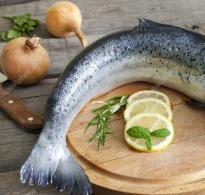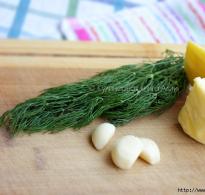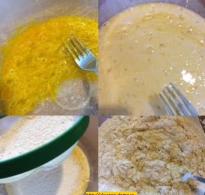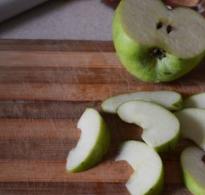Kiwano - exotic "cucumber. Kiwano - she is a horned melon
Kiwano is an exotic fruit native to Africa, which has become very popular and loved by many. Due to its unusual appearance and shape, its fruit is quite difficult to confuse with some other tropical delicacy. The kiwano fruit is somewhat reminiscent of a cucumber in appearance: it has an oval shape and a surface covered with pimples. The inside of the fruit is the core, which consists of a light green jelly with seeds.
In appearance, this plant is very similar to a vine. It is often used as a decoration in the garden. This is an unpretentious prolific exotic, resistant to diseases and pests. Other names are African cucumber, horned melon.
Benefits of Kiwano
 Kiwano fruit, unlike other exotics, has a diverse composition. 100 g of pulp contains: 89% water, 2% protein, 1.1% fat, 7.5% carbohydrates, 0.4% ash. In addition, the fruit is rich in B, A, C vitamins, as well as micro and macro elements (potassium, iron, magnesium, calcium, manganese, zinc). This is a low-calorie product - only 44% of calories, therefore it is suitable for dietary nutrition.
Kiwano fruit, unlike other exotics, has a diverse composition. 100 g of pulp contains: 89% water, 2% protein, 1.1% fat, 7.5% carbohydrates, 0.4% ash. In addition, the fruit is rich in B, A, C vitamins, as well as micro and macro elements (potassium, iron, magnesium, calcium, manganese, zinc). This is a low-calorie product - only 44% of calories, therefore it is suitable for dietary nutrition.

How to use Kiwano?
 Universal exotic is added to snacks and various desserts. After all, it is difficult to determine whether it is a fruit or a vegetable.
Universal exotic is added to snacks and various desserts. After all, it is difficult to determine whether it is a fruit or a vegetable.
Many are interested in the question of how to eat the Kiwano fruit. The fruit is divided in half and the pulp is removed with a spoon. Do not throw away the peel - it can be dried. In the future, the crust is used in the form of a decorative bowl for desserts or a bowl, in which various dishes are laid out or cocktails are poured.
Those who have tried kiwano not for the first time, being its gourmet, prefer to eat fruit in all kinds of salads. Pieces are used to decorate sandwiches and snacks. In addition, beautifully cut fruit is spread on ice cream, cocktails, various cakes and jellies. Its sweet and sour taste will add spice and amazing taste to any dish.
Kiwano can be eaten not only in its original, that is, raw form. The fruit is often salted and pickled.
For pickling, unripe fruits are used. Despite the fact that this exotic bears some resemblance to a pickled cucumber, according to gourmets, this exotic is much tastier than a green pickled vegetable.
Kiwano Salad Recipes

Growing kiwanos at home and in the garden
 Kiwano can be easily grown in our garden, on a balcony or even on a windowsill and get quite a good harvest. The conditions should be as follows - protection from direct sun (best - partial shade), from winds and drafts, sufficient watering. If the bright sun illuminates the vine at noon, then brown spots will appear on the leaves, and the ovaries will fall off. The soil should be very loose and permeable to air. The stems need support, but they need to be tied up. It is best to grow near a fence, wall, under a fruit tree. Some grow directly on the ground, where the stems spread.
Kiwano can be easily grown in our garden, on a balcony or even on a windowsill and get quite a good harvest. The conditions should be as follows - protection from direct sun (best - partial shade), from winds and drafts, sufficient watering. If the bright sun illuminates the vine at noon, then brown spots will appear on the leaves, and the ovaries will fall off. The soil should be very loose and permeable to air. The stems need support, but they need to be tied up. It is best to grow near a fence, wall, under a fruit tree. Some grow directly on the ground, where the stems spread.
 Seeds can be purchased at seed stores or removed from ripe fruit, dried, held in a nutrient solution, and planted in seedlings. In all other respects, caring for a kiwano is the same as for a cucumber: watering, weekly top dressing, pinching side shoots. Fruiting begins 2 months after sowing seeds.
Seeds can be purchased at seed stores or removed from ripe fruit, dried, held in a nutrient solution, and planted in seedlings. In all other respects, caring for a kiwano is the same as for a cucumber: watering, weekly top dressing, pinching side shoots. Fruiting begins 2 months after sowing seeds.
The plant almost does not get sick, but reacts very poorly to temperature changes. Therefore, it can be grown in a pot or tub and brought in at the first cold snap. If the loggia is closed, or you grow a kiwano at home, then you need to pollinate the flowers with a brush in the morning.
The most suitable variety for growing in the middle lane is the Green Dragon, which tolerates night cooling quite well.
In recent years, more and more lovers have appeared in our country who want to try something new to taste.
Due to this demand, grocery retailers are trying to diversify their assortment with exotic products as much as possible. One such exotic product is kiwano.
What is kiwano, its composition, how to choose and consume it correctly, and whether it is possible to grow kiwano from seeds, our article will tell.
Origin, growth
Kiwano can only be called a fruit conditionally. In fact, kiwano is a vegetable from the gourd family. A relative of the common cucumber.
This exotic fruit grows in Central America, Israel, New Zealand and Southern Europe. Kiwano has an unusual appearance - the shape of an orange with soft pimples all over the surface. The weight of the fruit is about 300 grams, the circumference is about 10 centimeters, the color is bright orange.
It grows on herbaceous vines, similar to cucumber ones, only with smaller leaves.
Kiwano is considered an unpretentious plant, resistant to diseases and various pests. Has a good yield. Reacts negatively to low temperatures.
INTERESTING! The original name of kiwano "horned melon" comes from its bright dense orange peel with spikes all over the surface. And the “African cucumber” kiwano was nicknamed because of the green pulp similar to the cucumber with soft seeds.
Composition, calorie content and useful properties
Kiwano is a low-calorie product, its nutritional value is only 44 kcal per 100 g, since it is 90% water.
The pulp of an exotic fruit is rich in vitamins A, C and group B. With its regular use, you can increase immunity and the overall resistance of the body to external factors. The presence of vitamins in the composition has a positive effect on the tonic function of the human body.
The beneficial properties of kiwano are due to the fact that folic acid, potassium, calcium, sodium, magnesium, phosphorus, iron, manganese, copper and zinc are present in its composition.
The presence of a large amount of potassium in the kiwano has a beneficial effect on the normalization of diseases of the gastrointestinal tract and the cardiovascular system.
REFERENCE! Kiwano is considered an environmentally friendly product due to its ability not to accumulate nitrates.
The rich composition of trace elements has a positive effect on the condition of the skin, increasing its elasticity. Kiwano pulp is often used for cosmetic purposes, adding it to masks that have a tonic and tightening effect.
In addition to the above, the pulp is used as a means of activating cell regeneration and promoting the rapid healing of wounds and stopping bleeding.
How to choose kiwano and how to eat it correctly
Delicious nod fruit
To choose the right tasty and ripe fruit, you need to follow a few simple rules:
- - the nod should be of medium size,
- - have a rich orange color of the peel with yellow spikes,
- – there must be no visible damage,
- - the fruit should not be soft, but rather should be dense and elastic.
How to eat it right?
Form of consumption
Kiwano can be eaten both green and fully ripe. It depends on the way it is used. Green fruits can be salted or pickled. It can be added when preparing compotes and jams.
But, most often, it is consumed raw, provided that the fruit is ripe. The fruits are cut in half and the pulp is selected from them with a spoon.
The taste of kiwano is sweet and sour; for some, its aftertaste resembles a mixture of cucumber and melon, for others - kiwi and banana. Some exotic lovers prefer to eat salted pulp, and some even add pepper to it.
Kiwano dishes
The pulp of ripe kiwano fruits is also used to prepare light salads, snacks and various desserts, up to cream for cakes. Kiwano juice mixes well with the juices of other fruits, giving originality to the drink.
In places where exotic fruit grows, the following dish is common - a kiwano appetizer with seafood and cheese. It is elementary to prepare. Kiwano pulp is mixed with seafood and soft cheese.
INTERESTING! Empty kiwano shells can be turned into an original piece of furniture. For example, if the halves of the shell, having previously washed well from the remnants of the pulp and dried, put on the “thorns” like on legs, then you can use such “dishes” as an interesting accessory for table setting.
How to store kiwano
Unripe kiwanos are best stored, and it is unripe fruits that are optimal for transportation. Kiwanos tend to ripen when plucked.
Ripe fruits can be stored at room temperature for several months.
Growing kiwanos from seeds at home
In order to try to grow a kiwano in our middle lane, you first need to grow seedlings. You can use seeds for its growth, both purchased and removed from a ripe fruit.
Seedling
Initially, the seeds are soaked for a day in a nutrient solution, with the addition of "sodium humate" or "epin-extra".
A day later, the seeds are planted in separate containers prepared for seedlings. The diameter of the planting containers should be approximately 10 cm. The seeds are deepened by 3 cm into loose nutrient soil and either placed in a greenhouse or covered with glass for at least two weeks.
It is necessary to ensure that the soil does not dry out and avoid direct sunlight.
As soon as sprouts appear, the glass on the containers with seedlings can be removed and you can wait for favorable conditions for planting seedlings in a greenhouse or in open ground. Since kivano is a heat-loving plant and extremely sensitive to low temperature changes, it is advised to plant seedlings in a greenhouse in the middle or at the end of May. Seedlings can be placed in open ground only when it finally warms up and the threat of frost has passed.
If the kiwano is planned to be grown in open ground, it is necessary to choose places protected from wind and direct sunlight. Also, it is important to ensure the possibility of weaving creepers, so it is recommended to plant seedlings in open ground near a fence or buildings. In the greenhouse, seedlings must be tied to a vertical trellis. The optimal distance between seedlings is 50-80cm.
Care
Further care for the kiwano is simple. It is necessary to provide the plant with regular watering, weeding and fertilizing every 10-12 days.
Experienced gardeners recommend alternating organic and mineral top dressing. When many side shoots appear, pinch them to the ovary. Empty flowers must be completely removed, and young ovaries should be removed every two days so that new fruits appear faster. The plant begins to bear fruit after 2 months.
INTERESTING! African kiwano cucumber can be perfectly grown in urban conditions, on a balcony or loggia. To do this, you need to choose the right pot with a volume of 5 to 25 liters and carry out pollination manually with a brush. Kiwano fruits can decorate your balcony or loggia in a very creative way.
Increasingly, on the shelves of supermarkets you can see outlandish fruits and vegetables that are imported from various countries of the world. Despite the fact that such delicacies are prohibitively expensive, they are sometimes in greater demand than the usual vegetables and fruits. Today we will discuss african fruit, find out what it is, how it is used, how it is grown from seeds, how difficult it is to grow in your garden.
Introduction to exotic fruit
It is for this reason that many people believe that most of the product after cleaning will go into the bin, respectively, only a small part of the pulp will remain, which will not cover the costs.
However, it is worth noting that the African cucumber has good fruiting, so if the fruit is grown for personal use, then you should not think that resources and land will be spent to end up with a kilogram of an edible product.An important question is what tastes like horned melon. Kiwano has a specific taste that cannot be identified with any familiar fruit in the same way as if you first tried a banana and tried to compare it with what can grow in the garden.  Generally speaking, the fruits have a sufficient amount of moisture and a sweet and sour taste that quenches thirst well. When you try it for the first time, you will feel similarities with cucumber, melon, banana and lime, but each person has his own analogy, so in this case everything rests on a subjective opinion.
Generally speaking, the fruits have a sufficient amount of moisture and a sweet and sour taste that quenches thirst well. When you try it for the first time, you will feel similarities with cucumber, melon, banana and lime, but each person has his own analogy, so in this case everything rests on a subjective opinion.
Did you know? The plant is used not only to produce fruits, but also as an ornamental plant, planting it in personal plots.
Seed preparation before planting
Before sowing, the seeds must be soaked for a day in a pre-prepared solution. To do this, we buy in a specialized store that has an identical name (do not confuse it with potassium humanate).
You can also use the fertilizer "Epina-extra", which gives the same effect. 
Sowing seeds for seedlings
It should be said right away that it is impossible to sow directly into open ground even if you live in southern latitudes. Recall that in the spring there can be serious temperature drops, respectively, there is a risk of losing all the seedlings at once.
Location selection
Kiwano requires a large amount of space, as it has accelerated growth and "spreads" quickly enough. However, like a regular cucumber, it does not interfere with support to make it easier to collect products.
Important! In no case should you plant under the dense crowns of trees, since you will not get a harvest before frost.
Therefore, it is worth planting on a flat surface near a mesh fence or wall. You need to leave a fairly large area for planting. In this case, the priority will be precisely a warm, calm place, and not the presence of a support. 
Landing pattern
The optimal landing is considered as such, if per 1 sq. m. there are no more than two bushes. The standard picking pattern is 40x35 cm.
How to care for an African cucumber
Now let's talk about the care of the African cucumber in the open field. Let's discuss the main points on which the productivity of the bushes depends.
Watering, weeding, loosening
Watering. You should not think that if a plant is from Africa, then for it you need to “arrange” the Sahara in the garden. Under such conditions, the nod will quickly die, and you will waste your energy in vain. You need to water at least 2-3 times a week, if it is not very hot outside.
If the sun bakes so that the earth cracks, then we water daily, checking the soil near the bushes for moisture with a stick or special electronic devices.  Please note that watering is carried out before sunrise or after sunset, otherwise the plant will suffer greatly from such irrigation.
Please note that watering is carried out before sunrise or after sunset, otherwise the plant will suffer greatly from such irrigation.
Weeding. Be sure to remove all weeds in the area where the crop grows. Do not forget that for the formation of the green mass of kivano, a large amount of mineral and nutrients is required, which are drawn from the soil.
Loosening. Loosening allows you to give the roots access to oxygen. It should be carried out when the earth is covered with a crust. This is best done in the early morning or evening. You can’t do this during the day, otherwise your actions will lead to the evaporation of a huge amount of moisture from the soil.
Did you know? The fruit contains a large amount of ascorbic acid, as well as a complex of other vitamins and minerals. Calorie content of 100 g of products - 44 kcal. This determines the usefulness of the fruit for people suffering from cardiovascular diseases and obesity.
Escape pinch
If you are not growing horned melon, then pinching is a must.  Be sure to pinch the side shoots, otherwise the volume of green mass will affect fruiting. We form the bushes so that they look like a circle or, if so intended, stretch into one continuous line.
Be sure to pinch the side shoots, otherwise the volume of green mass will affect fruiting. We form the bushes so that they look like a circle or, if so intended, stretch into one continuous line.
Hilling
It is not an important part of the care, however, if the soil overheats during the day, or just as strongly supercools during the night, then it does not hurt to hill up to protect the roots from overheating or hypothermia.
Hilling also helps retain moisture in the soil, which is especially important for southern latitudes, where summers are very hot.
top dressing
Top dressing is carried out without fail, while it is necessary to introduce not only organic matter, but also “mineral water” in order to ensure rapid growth and a set of green mass.  From organic matter, you can make an infusion, or chicken manure. From it is better to give preference to complex ones, which include the NPK complex.
From organic matter, you can make an infusion, or chicken manure. From it is better to give preference to complex ones, which include the NPK complex.
Garter
If you use a support, then you can vertically tie the main stem like a bee pollinated cucumber. So you can put the bulk up, while saving space. You can also use cucumber mesh, which is great for kiwanos.
You can do without a garter, but in this case, the vine will take up a lot of space, and when growing in a greenhouse, you certainly cannot do without a garter.
Harvesting
The fruits begin to be harvested in August, when they turn yellow. At this stage, they are perfectly stored, but the taste leaves much to be desired, because they taste like an overripe cucumber.  To get the most delicious fruits, you need to cut them at the moment when they turn bright orange. There is no need to wait to collect a large number of fruits at once, as this will slow down the formation of new ones.
To get the most delicious fruits, you need to cut them at the moment when they turn bright orange. There is no need to wait to collect a large number of fruits at once, as this will slow down the formation of new ones.
After harvesting, "horned cucumbers" are stored for no more than six months without freezing or refrigeration.
How to eat kiwano fruits
Having talked about how to grow kiwano, it is worth mentioning how to eat this fruit.
As you might guess, the peel is not used for food, so it must be removed. However, the edible part is so tender that it will not work to separate it from the skin like orange slices. Therefore, the fruit is cut into two parts, and the jelly-like "filling" is selected with a spoon.  Then it can be salted or sweetened, added to various dishes. If you like the taste of fruit, then you can use it without mixing with anything.
Then it can be salted or sweetened, added to various dishes. If you like the taste of fruit, then you can use it without mixing with anything.
helped
Kiwano attracts with its exoticism and ease of cultivation. In Russia, a variety has been bred, zoned for all regions. Seeds are commercially available. So why not grow this African fruit in your garden?
Description of kiwano, the purpose of the fruit
Other names for kiwano are African cucumber and horned melon. This culture is not new, it comes from Africa, is popular in Israel and New Zealand. It grows wild there like a creeper. It is not known in what year she came to Russia, but a description of the fruits can be found in books published in the 60s of the last century, and, probably, even earlier.
Kiwano grows in the wild, its whips spread along the ground or climb trees
Commercial success came to this exotic in the 1980s. It began to be grown and exported by farmers in New Zealand. Today Kiwano is grown on an industrial scale in Australia, Chile, USA, Germany, Italy, China. Fruits are delivered to almost all major supermarkets in the world. They have also become fashionable here in Russia.

Kiwano can be found in the supermarket among exotic fruits.
The word kiwano in each country has its own special spelling: Kewana, Kiwano, etc. Therefore, there are discrepancies in the Russian language.
Kiwano belongs to the gourd family, in terms of growth it strongly resembles a cucumber. It forms a long whip with stepchildren, there are male and female flowers, the leaves are similar to cucumber ones, only smaller. Only the fruits are strikingly different. In nods from the moment the ovary is formed, they look like hedgehogs, covered with thorns.

Kivano ovary just starting to grow
The Kiwano fruit is cylindrical and grows to the size of an orange. At full maturity, it becomes yellow-orange, while the flesh inside remains green. It has a jelly-like consistency and is full of seeds. Taste: from ordinary cucumber to sweet multifaceted, similar to a mixture of exotic fruits (kiwi, pineapple, orange, banana).
Both 5-7-day-old greens and already ripe fruits are harvested for food. Zelentsy are used like ordinary gherkins: they are pickled, added to assorted dishes and pickles. Ripe nods are cut in half and the flesh is eaten with a spoon. The pulp is also suitable for making jam, as well as cocktails with the addition of yogurt or honey. Fruits are stored at room temperature for up to 6 months.

Ripe kiwano is cut in half lengthwise or across and the flesh is eaten with a spoon
Kiwano is a record holder for potassium content, therefore it is recommended for those who suffer from cardiovascular diseases. In addition, freshly squeezed juice improves tone and strengthens the immune system. The rough skin is also eaten, it is rich in fiber and vitamin C. You may like another use: use the shells freed from the pulp as bowls for a spectacular serving of salads.

Empty kiwano halves are used to decorate dishes
Varieties and types of kiwano
In 2006, employees of the Central Siberian Botanical Garden (Novosibirsk) registered the Green Dragon Kiwano they bred in the State Register of Breeding Achievements. It is zoned for all regions of the Russian Federation. It can be grown in open and closed ground.
The Siberian Exot grows a lash 3 m long. 75–77 days pass from emergence to harvest. The fruits are oval, yellow, with tubercles, there is pubescence. The length of each is 6.5–8 cm, weight is 145–158 g. The taste is called good. The green dragon has a stable yield. 3.6 kg of fruits grow per 1 m² of beds.

Kivano Siberian selection Green Dragon
The State Register does not say anything about disease resistance, and the opinion of gardeners on this issue is divided. Some argue that the Green Dragon does not get sick, while others die from powdery mildew.
Interestingly, only this variety is known in Russia. Kiwano varieties are not mentioned at all on international portals, even on Amazon there is only one variety - Kiwano Cucumis melo, that is, all botanical names are collected together - kiwano (kiwano) cucumber (cucumis) melon (melo).
The Latin name for Kiwano is Cucumis metulifer. Cucumis is the name for a cucumber grown in ancient Egypt, metulifer refers to the thorns.
The Cucumis metulifer family includes 32 species, but only two are of commercial interest, have been cultivated and are grown far beyond their native Africa. These are Cucumis metuliferus (kiwano) and Cucumis anguria already known to us.

The fruits of Cucumis anguria are similar to kiwanos, but they also have obvious differences.
In our local stores, you can find Green Dragon Kiwano seeds, as well as bags labeled “Kivano” or “African Cucumber”, without the name of the variety and type. If these are not available in your city, order online. Kivano is sold in online stores: Gavrish, SeedsPost (Seeds by mail), etc. And of course, seeds can be collected from a fruit bought in a supermarket, only it must be fully ripe.

Kiwano seeds are freely available, produced by well-known agricultural companies
Sowing kivano
Kiwano is grown through seedlings. Sow seeds a month before planting in a permanent place. The culture does not tolerate frost, the optimum temperature for growth is +20 ... +26 ° C, at +12 ° C development stops. Therefore, it is necessary to plant in open ground in late May - early June, when warm weather sets in, and in a greenhouse or greenhouse - earlier, in early to mid-May.
Video: Kiwano seed collection, sowing, germination
Kiwano is not as picky about soil fertility as cucumber. The main thing is that the earth is loose, light and permeable. Use this one for growing seedlings: buy or make it yourself from humus, garden soil and baking powder (perlite, vermiculite, coconut fiber) in a ratio of 1: 1: 0.5. Sow to a depth of 2-3 cm in pots with a diameter of 8-10 cm. You can pre-soak the seeds in aloe juice or Epin's solution (2 drops per half a glass of water).
Kiwano seedlings are no different from cucumber ones, they also look like they prefer a warm and bright place, however, they cannot stand direct sunlight. Keep the soil constantly moist, but not damp. Top dressing during the seedling period is not needed.

Kiwano seedlings look like cucumber
Features of landing in a permanent place, care
By the time of planting, kiwano plants should have 2-3 true leaves. The bushes grow very strongly, from each you can collect a bucket of fruit. Therefore, it is not worth planting many plants for one family, an aggressively growing vine will take up a large space, it can strangle other cultivated plants with its lashes. Planting density - 2 bushes per 1 m².
Video: how one kivano bush grows in the open field
Grow kiwano in spreading or with a vertical tie. This plant is great for landscaping walls and fences. Flowering does not begin until a large green mass has grown.
Throughout the summer you will need:
- Watering 2-3 times a week.
- Top dressing every 10–14 days with complex fertilizer for cucumbers, zucchini and pumpkins (BioMaster, BioHumus, Fertika, Agricola).
- Formation in one stem. Stepsons (lateral branches) pinch after the appearance of ovaries on them, stepping back 2-3 sheets. And if there is only a male barren flower on the shoot, then break it out entirely.
Kiwano needs pollination by insects, therefore it is more productive in open ground. In the greenhouse, you will have to work as bees yourself and pollinate by hand, plucking the male flower and dusting it with pollen from the female stigmas.

The female flower of the kiwano, the male flower does not have an ovary near the base of the rudiment
Harvesting
Try kiwano at all stages of ripening, from green to fully ripe fruit. Whichever you like best, collect those. If you liked only ripe kivanos, then at the end of summer, when the temperature at night already drops below 12 ° C, pinch all the tops, tear off small ovaries and flowers, take them to the compost. Cover the bushes with agrofibre, the remaining large fruits will still have time to ripen. But you can pluck the nod at the very beginning of staining. They will be stored until spring and gradually ripen. Frozen fruits should not be stored.
If you prefer small greens, then collect them all summer before the onset of cold weather. But leave 1-2 fruits to ripen, which started at the beginning of the season, in order to collect seeds from them.
Video: Kiwano tasting
Some time ago, people did not think about how to grow kiwano, since this plant was not popular in our regions. But lately, more and more often we see this product on TV screens and on tables.
Kiwano is nothing more than a cucumber, but came to us from Africa. It is considered an exotic fruit, and in appearance it resembles a prickly melon. It has a yellow rind, and inside, the flesh in the form of jelly opens to the eye.
The reason for the popularity of the kiwano
Kiwano gained the greatest popularity when everyone learned about its beneficial properties. The fact is that the benefits of kivano for the human body take place, thanks to the content:
- Vitamin A, B, C,
- carbohydrates,
- proteins,
- fat,
- ash,
- gland,
- calcium,
- zinc,
- potassium,
- magnesium,
- manganese.
As you can see, the list is so rich that it doesn’t take long to explain why we should eat this fruit, and why we need to know how kiwano is grown. To briefly describe the most useful properties of kiwano, it is enough to say the following, the fruit significantly strengthens the human immune system, and gives it the necessary set of nutrients during the winter.
A large amount of water and potassium have a good effect on the functioning of the cardiovascular system. Being a dietary product, it can be eaten even by patients with diabetes. Dieters can also eat kiwano, enriching the body with vitamins that are so needed during this difficult period.
Fiber, which is part of the kiwano fruit juice, stimulates the intestinal tract well and removes all unnecessary elements.
We grow kivano at home, in the country
After making sure that this plant deserves to be grown at home, let's study the features of this process. After all, after all, this is an exotic product, which means it requires some attention on your part.
Kiwano cultivation at home is carried out mainly by seed. There are other options, but this is considered the most effective. Moreover, the requirements for this process are quite small, which means that even a novice gardener can handle it.

Kiwano (photo)
The process begins about 30 days before the fruit is planted in the garden. Since this procedure is planned somewhere in the middle of spring, it is required to start working with seeds around the beginning of the spring period.
So, growing kiwano from seeds occurs in the following order:
- Kiwano seeds are soaked in a jar containing a solution of "sodium humate" or "epin-extra";
- prepare small pots about ten centimeters in diameter;
- fill each pot with nutrient soil;
- 24 hours after soaking, when the seeds swell, they are sown in pots and placed in a greenhouse, where they should be at least two weeks;
- it is possible to plant a kivano fruit on a garden bed only when there is a guarantee that there will be no frost on the soil, otherwise the plant will not survive;
- when the time has come, we plant all the nodule seedlings in the garden so that there is a distance of at least 40 centimeters between them;
- when choosing a place for a garden bed, you need to know that the kiwano does not like direct sunlight, although it is a native of Africa;
- avoid planting the plant in a draft, this will also lead to its death;
- the fruit loves soil that is porous and breathable;
- remember that kivano does not like drought, but also does not tolerate excessive moisture;
- for the plant to grow and develop properly, tie each sprout to a peg vertically;
- it is important not only to properly plant the kiwano, but also to create the right conditions for its care.
Caring for the Kiwano, an African miracle
The requirements for caring for this exotic plant are aimed at creating the most comfortable conditions for its growth and development. This will ensure you get a good and regular harvest in the future. There are some nuances that you should pay attention to:
The mode of watering the fruit must be set so that the earth around it does not dry out, but is not constantly wet. Kiwano does not like swamps. The approximate frequency of watering is twice a week, but it happens more often in the case of a dry summer.
The bed where it grows cucumber(kiwano) must be constantly loosened, both before and after watering. This will ensure the flow of air and water to the root system of the plant. In addition, weeding allows you to remove all weed plants in the garden, and this significantly improves the condition of the fruit.
The plant is very good at feeding. At the same time, it is necessary to constantly alternate fertilizers with a mineral composition and organic. The use of mullein, chicken manure or herbal infusion has a very positive effect on the development of cucumber. It is also recommended to use all kinds of trace elements for foliar feeding.
Watch for the appearance of pests, and respond to such attacks in time with the use of appropriate preparations. If your plants have grown strongly, then you must definitely pinch the extra shoots. Also, watch for the appearance of barren flowers and remove them in time, as they only take extra strength from the plant.
During the harvest period, it is required to remove ripe cucumbers every two days to allow new fruits to appear. After the ripening has stopped, you need to collect all the cucumbers, and yourself plants used as compost.
As you can see, there is nothing particularly difficult in growing Kiwano and caring for this exotic plant. A little attention is enough, and you will get a great healthy fruit on your table. In appearance, the fruits are more capricious than they really are in life.






